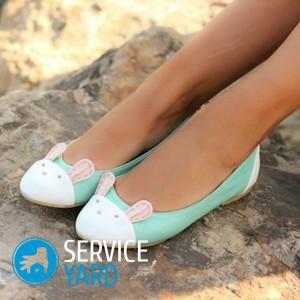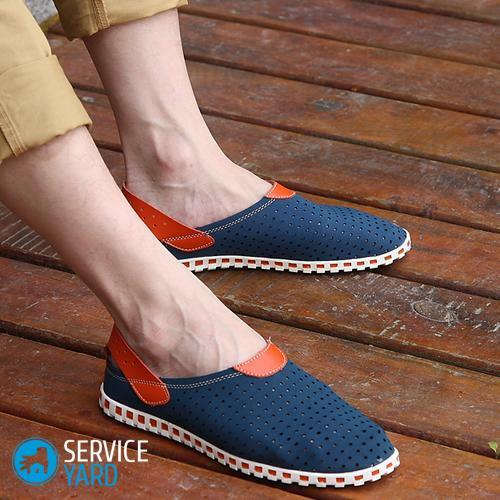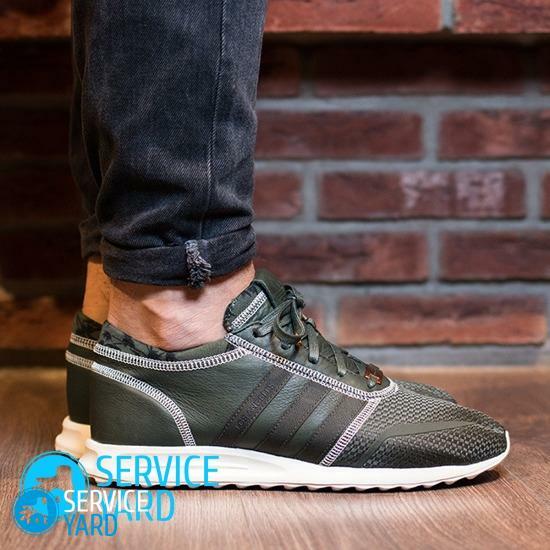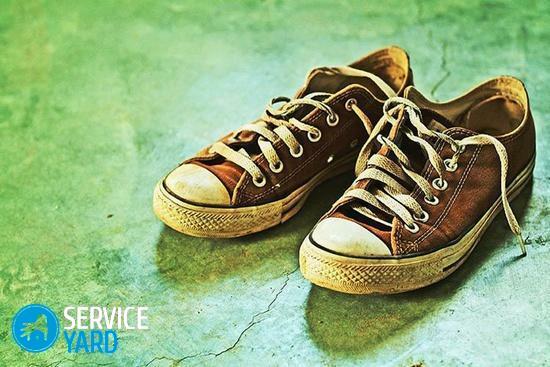
- Why is the shoe rubbing his feet?
- We buy shoes correctly
- We customize shoes for ourselves
- What if they rub sneakers?
- How to protect feet from hard shoe backs?
- Treatment of dry calluses
Each girl, when she purchases new shoes, already presents herself as defiling along the street, but nothing can give such a spectrum of a variety of emotions from joy, happiness and suffering, like new shoes. During fitting, stylish shoes seem to us imperceptible on the legs and stunningly comfortable, but it's worth taking only a few steps down the street, and now we can not help thinking about what to do so that we do not rub our shoes.
Usually, new shoes rub the corns almost always, no matter how carefully you choose shoes, and from what soft material they would not be made. In this article, we'll look at how to soften shoes, so that they do not rub or saddle the joy of buying.
to the contents ↑Why is the shoe rubbing his feet?
Some women deliberately try to buy shoes of a slightly smaller size just because it seems to them that the leg in such a new outfit will look much more neat and tiny. However, literally from the first tens of meters of the fashionista are severely disappointed, and the grinded heels can spoil the pleasure of the desired purchase. But often we have to suffer from shoes of your own size. Reasons for which the shoe rubs our feet, there may be several:
- New material. If rubbing new shoes, then do not bear it right back. New material, as a rule, always causes a slight inconvenience, discomfort, and this must be treated with understanding.
- Not your size. As for the size, then all people are different, and shoes are produced according to certain standards. Therefore, to choose shoes of its size and so that shoes do not rub at all, it is quite difficult.
- Inconvenient seam. To rub the calluses is also capable of an uncomfortable seam on the shoes, and this problem is already more serious than the previous ones. A rough seam can rub the legs so that the heel deforms, and you can never again pick up good shoes for yourself. The main thing is that with such a problem not reach the operating table in search of ideal beauty.

Important! If the shoe is rubbed due to incorrect seams, then it is worth carrying it back to the store, since walking in it will be painful and uncomfortable. If you do not want to change a new thing, and everything suits you, except for this terrible seam, then try to get rid of it by taking shoes to the workshop where an experienced shoemaker will put a soft patch on the seam.
to the table of contents ↑We buy shoes correctly
So that we do not rub our shoes, we must make the purchase correctly. To do this, you must adhere to simple rules:
- Buy new shoes at the end of the day, that is, in the evening. This is a fairly simple explanation: it is in the evening that a person's leg slightly increases in size. As practice shows, bought in the evening, boots or shoes, do not rub your foot for tomorrow morning, and even at other times in the process of their further exploitation.
- New shoes must first be worn to get by, in the future, without painful water blisters. Use for this purpose the old folk way, which allows for a new dress to "sit down" on the leg: soak a cotton swab with alcohol, moisten cotton wool all the places where rubbing callouses.
Important! If the shoes are closed and rubbed with alcohol inside it is quite difficult, then use a more efficient method. Rinse the shoe from inside with alcohol, and on the legs put on warm socks and for a while walk around the house.
- When buying shoes, be sure to try on her not only sitting, but also standing at full height to check how she sits on her leg.
- So as not to rub your shoes, remember, the more quality the shoes you buy, the less problems it will deliver after purchase.
Customize your shoes for yourself
The problem with rubbing the corn "is as old as the world", and people have learned to cope with it successfully. There are a lot of different tricks with which you can avoid the hassles that put brand new shoes on your proprietress. There are a lot of ways to fit the shoe "under the foot", choose those recommendations and tips that will help you to fix the seemingly most hopeless situation.
Popular advice:
- In order not to rub shoes, if the problem is in the back of the shoes, use the grandfather's method: tap on the back of the hammer - behind, inside, outside and above. Between the back of the shoes and the hammer, put a piece of cloth to avoid damaging, scratching and deforming the product itself.
- A soap or a candle is a good way to soften the back of your shoes. Apply the chosen agent to the problem site. This will soften the interior trim and reduce friction. Repeat the procedure several times a day until the shoe is worn and stops squeezing.
- In order not to rub shoes in the heel, soak a small towel in the vinegar and put it in a problematic shoe. Leave the shoes for the night.
- If the question is how to soften the shoes, so as not to rub and slightly expand the products of a smaller size, moisten a small rag in boiling water and put in the shoe( pre-pressing).After 15 minutes, put the problem shoes on your foot with a warm toe. Walk around the house for about 2 hours and the result will not take long.
- Rip the newspaper into small pieces and moisten them with water. Firmly pound wet paper into shoes, especially in those places where it rubs. After the newspaper pieces have dried, the shoes will slightly increase in size and stop squeezing their legs. Do not try to speed up the drying process. Do not place shoes under the radiator and do not dry with other heaters. Shoes themselves will dry, about a day later.
- In order not to rub shoes made of natural materials, it can be slightly expanded as follows:
- In 2 strong plastic bags pour water and tighten them tightly.
- Place the bags in the shoes in such a way that they are in the wrong places.
- Put the shoes together with the packages in the freezer for the night.
- In the morning, take out your shoes and remove the ice packs, but do not remove ice until it is wet, as the bag can freeze to the inner surface of the shoes.
Important! This method can be used only for shoes made of genuine leather, but experiment with lacquered and expensive branded shoes should not be.
- If your favorite leather boots after the summer season have become tight, then apply a thick layer of baby cream on them, and leave for 3-4 hours to impregnate. After the procedure, the shoes will again become soft and comfortable.
- Before you leave the house in the newly bought brand-new shoes, grease your feet with a fat cream( children's can).The skin on the legs will become much softer, and the shoes will not so rub.
- Before putting on new boots or shoes, lubricate the inside of the shoe with castor oil. Such a procedure, you not only help to wear the shoes, but also will provide a beneficial pleasant service to your legs.
- Wrap the box with new shoes at night with a wet towel. Since morning such shoes will be much easier to wear.
- To soften the back of the shoes use glycerine, which can be bought at any pharmacy. First you need to expand the pores of natural leather. To do this, place a hot wet towel inside the shoe. After 15 minutes, lubricate the backs of the inner side with glycerin and leave it overnight.

Special means for rubbing shoes
If, for some reason, all of the above folk methods are not suitable, then go to the shoe store. This is where you will be offered a lot of effective tools and devices that will help to cope with the problem of rubbing and discomfort. Here are some recommendations:
- Buy a special spray-stretch or foam-stretching. Apply the product to the inside of the shoe in places where corns can appear. Then put on your shoes and go home for a while. Repeat the procedure several times a day until the desired result is obtained.
- Use a stretch spray to avoid rubbing the shoes, as follows:
- Warm up new shoes or boots from the inside with a hair dryer.
- Rapidly rub the inside of the shoe with a stretch spray.
- Put a tight toe on your leg.
- Walk in the shoes for a while, before the inner surface cools.
- Repeat the procedure several times until the desired result is obtained.
- Buy special soft strips from rubbing shoes. Stick the strips on the inside of the shoe in places where corn can appear. Strips will reliably protect the skin of the legs from unwanted friction.
- Small silicone pads are mounted on the inside of the inside of the shoes and protect against the formation of calluses.
- Special pads are sold in stores, which will allow not only to expand the new footwear quickly enough, but also to give it the necessary form and size.
What to do if rubbed sneakers?
A shoe made of artificial materials: leatherette, textile materials, synthetic, can also be softened and slightly increased in size. To soften the back, so as not to rub shoes, you can use the following tools:
- Vegetable oil. Moisten a cotton swab with vegetable oil and process the back of the shoes from the inside. Leave the products in this form for several hours( preferably at night) for impregnation.
Important! Usually, flaxseed oil is used for this procedure. Do not feel sorry for him, and just drip the excess with a napkin.
- Alcohol. This substance does not contain acids, so it is not able to corrode synthetic materials. Nevertheless, use it carefully: dilute the alcohol with water and treat the backside from the inside, and then remember the problem place with your hands.
Important! Before you soften the shoes, so as not to rub, by this method, check if there are any cardboard packing inserts in the backs. From getting wet cardboard can not only soften, but also be deformed, that is, lose shape.
- Glycerin. Universal means suitable for anyone - both leather and artificial footwear. We wrote about the method of its application above.
How to protect your feet from the hard back of your shoes?
Hard toe shoes are a problem that is completely solvable, but it requires some effort and time. However, if the backs of boots or other shoes were hard, then the task becomes more complicated, since it is impossible to get to the problem place due to the high bootlegs.
Neither a hammer nor other mechanical tools will help here, and it is not easy to wet the back of the inside. It remains only to try to protect and protect the heels from the hard back of the shoes. For this, there are the following tools:

- Pencil from corns. Multifunctional means creates a lubricating effect and simultaneously softens the backs, that is, makes the inner surface of the boots sliding. The product is produced in a convenient package-stick, does not damage shoes, leaves no traces, neither on it, nor on pantyhose. A pencil against calluses also protects the heels from rubbing.
- Adhesive plaster. To protect the heels from the hard back of the shoes, glue the double layer of the patch: one directly on the foot, and the second - on the inside surface of the shoe.
Important! Adhesive plaster is not very effective, because when you wear it can get unstuck and get lost in the ball, while rubbing the skin even more.
- Silicone pads. In combination with an adhesive plaster, silicone pads effectively protect the heel. Stick the product inside the shoe so that the foot does not slip and does not rub the heel against the back.
- Patch. This method is suitable for shoes that are just on the foot or a little too long in size, otherwise, you will shorten the free space inside the shoe even more. Glue or sew on the inside of the shoes any patch of soft cloth. It will save you from hard backs, and if necessary - it will close your leg from the hard seam.
Treatment of dry corns
Corn on the foot is a problem that always causes a lot of inconvenience. Corn does not form immediately, but appears within a few days. As a rule, this is an extremely long process. After several years of using tight and uncomfortable shoes, a mound of dead skin is formed, which is called dry callus. Corns of this type begin to ache and cause a lot of inconvenience. Every step is difficult and painful.
Consider folk remedies for combating dry calluses:
- The simplest way to remove corn is a soap-soda bath. Just pour 1 l of warm water into the basin, then pour a little soap and soda into it. Hold the feet in the solution - 15 minutes, rub the problem place with pumice, rinse with water, wipe with a towel and apply a nourishing cream. To enhance the effect, in the soap-soda bath you can add infusion of chamomile.
- Compresses of tincture of garlic on wine vinegar, in the ratio: 1 clove of garlic per 1 tbsp.vinegar. After a 2-week infusion, compress at night.
- Onion husks. Fold it in a jar, pour it with vinegar and persist for 2 weeks. Then drain the vinegar, and apply the husk at night to the problem site, lubricating it with a vaseline or greasy cream beforehand.
Universal and 100% effective way to soften shoes does not exist. The choice of this or that method depends on the material of the footwear, on the style and on the many other features of the particular pair. If you can return an unsuccessful model to the store, then use it. If there is no such opportunity, then use our advice and folk wisdom, and next time be sure to choose the shoes correctly.



